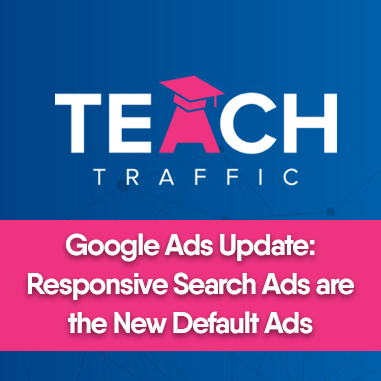Google Ads Update: Responsive Search Ads are the New Default Ads
Back on Feb 18, 2021, Google announced that Responsive Search Ads or RSAs will be set as the default ad type when you’re creating ads in your Search Campaigns.
So what’s next for you as an advertiser?
This major update in the default ad type from Expanded Text Ads (ETAs) to Responsive Search Ads (RSAs) means that every time you wanted to create a new text ad, there will be only two options that will appear: Responsive Search Ads and/or Call Ads.
“Wait, does this mean that our Expanded Text Ads (ETAs) are going to get discontinued?” “Should we panic now?” –
The answer is no, at least not yet so don’t rush and panic by hitting the panic button. Note that Google Ads themselves still recommends that having the following in your Search ads: two (2) ETAs and one (1) RSAs per ad group is still the best practice.
But this change meant that RSAs will be now replacing ETAs as the default Search ad type.
Google’s reasons for the switch
According to Google here are a few reasons why the switch:
Machine learning means improved ad performance
In recent updates from Google, we noticed that a lot of it has done anything with automation. Google has taken a strong stance on automation since for them machine learning can improve your campaign’s performance in terms of the following: clicks, conversions, and flexibility.
It’s adapting better with consumer behavior
The only constant in the world is change, and consumer needs to come into that change. Their reason for this is to give advertisers a more flexible and better way to adapt to ever-shifting market trends without having to resort to creating individual text ads and do the grueling work of testing them out manually to see which ones work and which do not.
A more streamlined account management and optimization
According to Google, they wanted more advertisers, especially novice advertisers to use RSAs more since it provides their machine learning mechanisms to work with. And by this, it allows them as well to give more recommendations to advertisers’ account performance and this will help them streamline better their account management experience in the Google Ads platform.
I’m new to Google ads, what is the difference between RSAs vs ETAs?
In Expanded Text Ads (ETAs) you can only have the following on your text ads:
- 3 Headlines (30 Character Limit)
- 2 Descriptions (90 Character Limit)
Take note that these headlines will strictly appear in chronological order when you launch your text ads and it will never change position so it’s important that you write your ETAs effectively.
On the other hand, Responsive Search Ads (RSAs) you have the following:
- 15 Headlines (30 Character Limit)
- 4 Descriptions (90 Character Limit)
In RSAs, you will have more flexibility due to the 15 headlines and 4 descriptions you can play with. This is great since you will be able to mix and match various headlines and descriptions based on a user’s search. But the negative side of this is you won’t be having any control on what headline and descriptions will appear when a search is performed and your RSAs are triggered to appear.
RSAs will take up a bit of time to create as well since you have to come up with 15 different headlines compared to ETA’s 3 headlines. But luckily for us, Google provides recommendations on what headlines to use for RSAs if they detect that you didn’t fill up the 15 headlines.
There is also a ‘Pin’ option for RSAs which you can use for up to three headlines and two descriptions. Pinning lets you choose which headlines and descriptions are sure to show in search results when they are triggered to appear. Though pinning isn’t recommended as this restricts Google’s automatic variant testing that runs through your RSAs. So pin only when it’s very necessary.
To sum it up, both ad types have both pros and cons.
How do you respond to this change?
Regularly test out your RSAs for a diverse mix of ad copies
Advertisers should adapt by constantly updating and testing variations of their ad copies. Though this is a best practice and age-old one, lots of us are quite guilty that we don’t commit to testing regularly.
Note that testing ad copies helps us, advertisers, to improve our ads overall since through testing we will be able to know which ones work and which ones don’t but it also allows Google to better match our ads to a particular search or user.
Carry on and continue creating and testing your ETAs
RSAs emphasizes and encourages testing for your ads to do better overall, but still, continue using ETAs while using RSA as a supplement for your campaign.
It shouldn’t be a surprise to advertisers that manually written ads can outperform Google’s machine learning written ads, but Google’s move to set RSAs as default ad in ad creation is to encourage advertisers to adapt, especially for novice advertisers who don’t understand yet the huge difference between the two ad types.
So it’s highly recommended to continue running and testing 2 to 3 ETAs in each ad group with RSAs as your supplementary ad since this will allow you to practice your ad writing skills and to optimize your ad copies as well while benefiting from a testing standpoint from Google’s machine learning.
